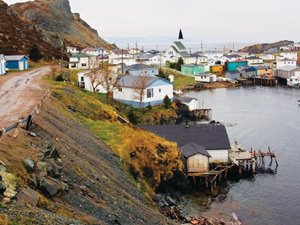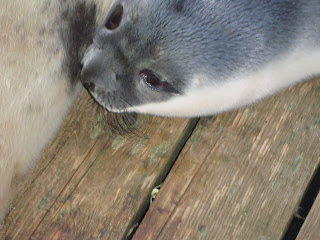Many residents of Harbour Mille, myself included, were on a rollercoaster ride of emotions last week. Some of us are still trying to recover from having the cruelties of nature thrust right in our faces. We learned a harsh lesson. Nature can be beautiful and leave us in awe of its magic, but it can also be cruel and difficult to look at. We also learned that toughened hunters and fishers can still have a soft sport for the vulnerable and needy in nature.
Despite capturing the hearts of an entire region, a baby seal that was born on the community wharf in the outport community of Harbour Mille has died. Sometime in the early morning hours of March 21st, a female hooded seal gave birth, or whelped as it is called in the seal world, to a pup. The pup, known as a blueback for the slate-blue colour across the top of its body, was an instant hit.
That morning a friend of mine waved me down just as I was backing out of my driveway. ‘You have to have a look,’ she told me excitedly, adding that I wouldn’t believe it unless I saw it for myself. My 13 year-old son and I took a gander and were instantly in awe. What an amazing sight. There, on our community wharf, was a mother seal, spotted in colour (so much so that my son and I immediately started referring to it as a leopard seal though we later found out that wasn’t her species at all) lying peacefully next to this little cream colored infant. Though we remained at what we considered a respectable distance, we were still close enough to see the umbilical cord was still attached to the baby. Momma seal looked up at us but made no attempt to prevent us from gazing as she nursed her pup.
We took a few pictures and left, figuring the pair would make our local floating dock their home for at least a few more days before once again heading for less public and more peaceful surroundings.
While I later discovered that it wasn’t unusual for a hooded seal to give birth on land, what was odd was her choice of a birthplace and nursery. Our usually busy wharf was made even busier because an extension to the floating dock was underway at the time. While most were respectful of momma and baby, work on the wharf still went ahead as planned. The pair of visiting mammals seemed to take it all in stride. While we at first thought momma seal’s demeanor was simply due to the exhaustion of giving birth, there were signs that things were not as they should be with this wild creature.
As the days past more and more people began showing up to take pictures of the pair and little by little visitors stopped zooming in with their camera lenses and simply got closer to the subjects of their curiosity. The fact that mother seal was not protesting this invasion should have caused more concern that it did.
Elderly men from our community stood watch when local young ones were out and about, often driving idle and curious boys away with little more than a stern look. They knew momma seal wasn’t acting quite right as she didn’t appear able to threaten anyone who came too close.
Still, most of us continued to celebrate the miracle of life that was right before our eyes. My son and I, using binoculars from our living room window, watched often throughout the day. The first thing I did every morning and the last thing I did each night was look to see if the pair were still there. I celebrated the sight, still, I also knew I would welcome the day when they were gone. I had pictured in my head the two going off into the sunset to finish their seal lives in the ocean, though I knew the reality was that one day baby would be on his or her own.
Hooded seal pups are about three feet long at birth and weigh about 24 kilograms (53 lb) at birth. They are usually born on the ice from mid-March to early April and they come into this world with a well-developed blubber layer. One of the fascinating parts of this tale is that the nursing of the hooded seal pup lasts for only around four days, the shortest lactation period of any mammal. While it may only be a short nursing period the pup will double in size and have enough fat to live off for a month before it begins to eat sold food. We witnessed our pup benefit from those first few days of fatty milk as it literally seemed to grow in front of our eyes. Hooded seal milk has an unusually high fat content of 60%.
Still, at least one local resident started to worry that the adult seal wasn’t nursing her baby. She first went down Sunday afternoon, taking her children with her to take some memorable photos. As she and her children approached the mammal pair she grew more concerned, saying that the mother should have done more than simply open one eye.
On the three trips she made down to the wharf on Sunday she never once saw the mother seal turn over to allow her pup to nurse. She thought about doing something, but she wasn’t sure what could be done.
Early the next morning, as divers showed up to complete the instillation of the newest section of dock, the mother died. Workers and residents rolled the dead seal over so the baby could get at the last of the milk. The pup nursed savagely.
DFO were notified. Something had to be done to help this baby seal who didn’t stray far from its mothers side, nursing (or trying to) from an unresponsive mother.
DFO officials visited the community but decided that baby would be comforted for one more night next to its mother. They would come again on Thursday, they said, after the storm forecasted for Wednesday was over.
By Wednesday morning it was clear something had to be done as soon as possible. The seal pup appeared smaller and sucked more desperately from its mother. The fear was that this creature, whom we were all growing attached to, would starve to death in front of our eyes. There was nothing anyone could do locally.
Hooded seal pups, after they are nursed for their initial four days, are then set off on their own to rest. They live off their accumulated fat for a month until their system can handle sold food then, then, when hungry, they set off into the ocean in search of food. Feeding the infant seal milk or kippers (as some proposed to do) would have done more harm than good. The only hope we had was that baby had nursed long enough from its mother.
DFO officials, summoned by locals and media alike, decided not to wait the extra day. Arrived in the worst of the ice storm that Wednesday, they gently placed the pup in a cage and placed it in the back of their truck. Mother was also going along for the ride. The pair would be traveling to St. John’s where the adult seal would be analyzed to determine what killed her. Baby would be checked over and its health and viability determined.
We were given hope when we learned that baby was cooperative, but feisty, and were comforted when told that the pup, like many traveling infants, had slept on the way into St. John’s.
But the next day brought tragic news. Hooded seal pups at the five day mark should weight around 40 kilograms. Our seal was only 27. There was no way it could survive for the month it would take for its system to be able to tolerate a regular seal diet.
The pup we had tried so hard to save was euthanized.
While many residents feel the tragedy of the situation they also accept that the right thing was done. No one here had the heart to watch a seal pup starve to death in front of our eyes, and we certainly wouldn’t want it to starve slowly to death anywhere else. If the pup couldn’t make it in the wild, then putting it to sleep was the right thing to do. We were just all hoping for a happier end to this story.
Tuesday, March 30, 2010
Subscribe to:
Post Comments (Atom)







No comments:
Post a Comment